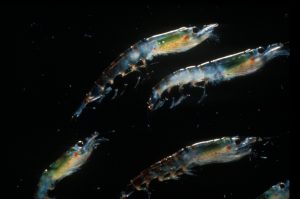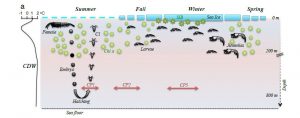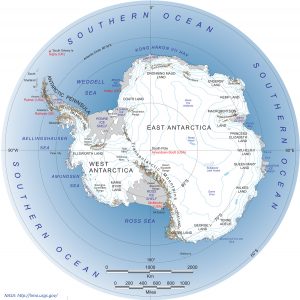16 August 2016
WASHINGTON, DC — Antarctic krill, small crustaceans key to the Antarctic marine food web, could lose most of their current habitat by the year 2100, according to a new study. Researchers combined climate simulations with a krill growth model to find that changes in water temperature and sea ice in Antarctic waters could shrink krill habitat by as much as 80 percent by the end of the century, potentially causing a decline in krill that could ripple throughout the entire marine food chain.

Antarctic krill, centimeter-long shrimp-like crustaceans that feed primarily on phytoplankton, are a key part of the Antarctic marine food chain. A new study finds that Antarctic krill could lose most of their current habitat by the year 2100.
Credit: NOAA NMFS SWFSC Antarctic Marine Living Resources (AMLR) Program
Antarctic krill are centimeter-long shrimp-like crustaceans that feed primarily on phytoplankton, the small algae at the base of the marine food chain. Krill are an essential energy source for whales, penguins, seals, squid, fish and other marine life. Humans also fish for krill, which is used for aquarium food, fishing bait, pharmaceuticals and in some foods consumed by humans.
Adult krill populations have dropped by 80 to 90 percent since the 1970s. There is an ongoing scientific debate about what is causing the drop, from changes in the environment to an increase in whale populations, said Andrea Piñones, a marine scientist at Center for Advance Studies in Arid Zones (Centro de Estudios Avanzados en Zonas Aridas) – Coquimbo, Chile, and lead author of the new study published online in Geophysical Research Letters, a journal of the American Geophysical Union.
The new study seeks to understand the additional pressures krill could face in the coming decades as the climate warms. The life cycle of Antarctic krill is closely tied to many factors, including water temperature and the availability of sea ice, Piñones said. While other studies have looked into how ocean acidification, overfishing or more freshwater entering the sea from melting Antarctic glaciers could affect krill habitat, the new study examines the effects of a warmer ocean and a decline in sea ice on these small crustaceans, she said.
Understanding the effects of climate change on krill could help scientists understand what might be in store for the entire Antarctic marine food web, Piñones said.
“The idea is to give scientists a projection of how krill are going to do under these high (carbon dioxide) emissions scenarios,” she said.

This figure depicts the early life cycle of Antarctic krill. Krill start their lives in the summertime when females lay eggs near the surface. As the eggs develop, they slowly sink to depths of 700 to 1,000 meters (2,300 to 3,300 feet). After the eggs hatch, the krill larvae swim up to the ocean surface to feed during the rest of summer and early fall. The krill overwinter underneath sea ice and molt into juveniles during spring.
Source: American Geophysical Union
Most Antarctic krill live in an area that spans from the Weddell Sea to the waters around the Antarctic Peninsula. They start their lives in the summertime when females lay eggs near the surface. As the eggs develop, they slowly sink to depths of 700 to 1,000 meters (2,300 to 3,300 feet) – the realm of the Circumpolar Deep Water current, a mass of deep water slightly warmer than Antarctic surface waters. At this depth, the water is a cozy 2 degrees Celsius (35.6 degrees Fahrenheit), about 1 degree Celsius (1.8 degree Fahrenheit) warmer than the water at the surface. This is the ideal temperature for krill egg development. After the eggs hatch, the krill larvae swim up to the ocean surface to feed. If they cannot find food, the larvae will starve after about 10 days.
Climate models predict that as the oceans take in more heat from the greenhouse effect, the waters of the Circumpolar Deep Water will warm 1 to 1.5 degrees Celsius (1.8 to 2.7 degrees Fahrenheit) by the end of the century. Meanwhile some surface waters around Antarctica are projected to warm by as much as 2 degrees Celsius (3.6 degrees Fahrenheit). A little warming of the water means krill eggs will develop faster, they will not sink as deep below the surface, and the eggs will hatch earlier and rise to the surface sooner, according to the new study. But krill larvae can only withstand temperature changes of up to 2 degrees Celsius (3.6 degrees Fahrenheit), Piñones said.
“Higher than 2 degrees Celsius and they won’t develop,” she said. “There are physiological limits.”
If the larvae make it past that first 10-day hurdle at the surface, they face a second challenge in the late summer and early fall when they need to fatten up make it through the winter. The last hurdle is their first winter, when juvenile krill depend on the sea ice algae for food, and crevices in the ice for shelter through the winter.
“The time when sea ice is found is very essential for the early life cycle of krill,” Piñones said. “The key here is that sea ice has been advancing later and retreating earlier in the regions where krill is declining.”
Climate models predict a 90-day delay in the formation of winter sea ice by the end of the century, Piñones said. Less winter sea ice means less food and shelter available for krill juveniles, which means fewer young krill will survive to adulthood and spawn the next summer, she said.

Most Antarctic krill live in an area that spans from the Weddell Sea to the waters around the Antarctic Peninsula. A new study finds that warmer waters and lack of sea ice could lead krill habitat to shrink by as much as 80 percent by 2100. At that point, only localized regions along the western Weddell Sea, isolated areas of the Indian Antarctic sector and the Amundsen/Bellingshausen Sea will support successful spawning habitats for krill, according to the new study.
Source: NASA
The warmer waters and lack of sea ice could lead krill habitat to shrink by as much as 80 percent by 2100, according to the new study. At that point, only localized regions along the western Weddell Sea, isolated areas of the Indian Antarctic sector and the Amundsen/Bellingshausen Sea will support successful spawning habitats for krill, according to the new study. The loss of krill habitat could cause krill populations to decline, although the new research did not quantify the drop in krill, Piñones said.
A loss of krill could have consequences that would cascade throughout the food web of marine mammals and seabirds whose rely on the crustaceans as their main source of food, according to Piñones.
“Just about everything you can think of in the Antarctic depends on Antarctic krill,” confirmed biological oceanographer Kendra Daly of the University of South Florida in Tampa, who was not involved with the new study.
###
The American Geophysical Union is dedicated to advancing the Earth and space sciences for the benefit of humanity through its scholarly publications, conferences, and outreach programs. AGU is a not-for-profit, professional, scientific organization representing more than 60,000 members in 139 countries. Join the conversation on Facebook, Twitter, YouTube, and our other social media channels.
Notes for Journalists
This research article will be freely available for 30 days from the date of publication. A PDF copy of the article can be downloaded at the following link: http://onlinelibrary.wiley.com/doi/10.1002/2016GL069656/pdf
After 30 days, journalists and public information officers (PIOs) of educational and scientific institutions who have registered with AGU can download a PDF copy of the article from the same link.
Journalists and PIOs may order a copy of the final paper by emailing a request to Lauren Lipuma at [email protected].
Please provide your name, the name of your publication, and your phone number.
Neither the paper nor this press release is under embargo.
“Projected changes of Antarctic krill habitat by the end of the 21st century”
Authors:
Andrea Piñones: Department of Geology and Geophysics, Yale University, New Haven, CT, USA; Centro de Estudios Avanzados en Zonas Áridas (CEAZA), Coquimbo, Chile; and Centro de Investigación Dinámica de Ecosistemas Marinos de Altas Latitudes (IDEAL).
Alexey V. Fedorov: Department of Geology and Geophysics, Yale University, P.O. Box 208109, New Haven, CT, USA.
Contact Information for the Authors:
Andrea Piñones: +56 51 2673259, +56 9 90858120 (cell), [email protected].
Lauren Lipuma
+1 (202) 777-7396
[email protected]